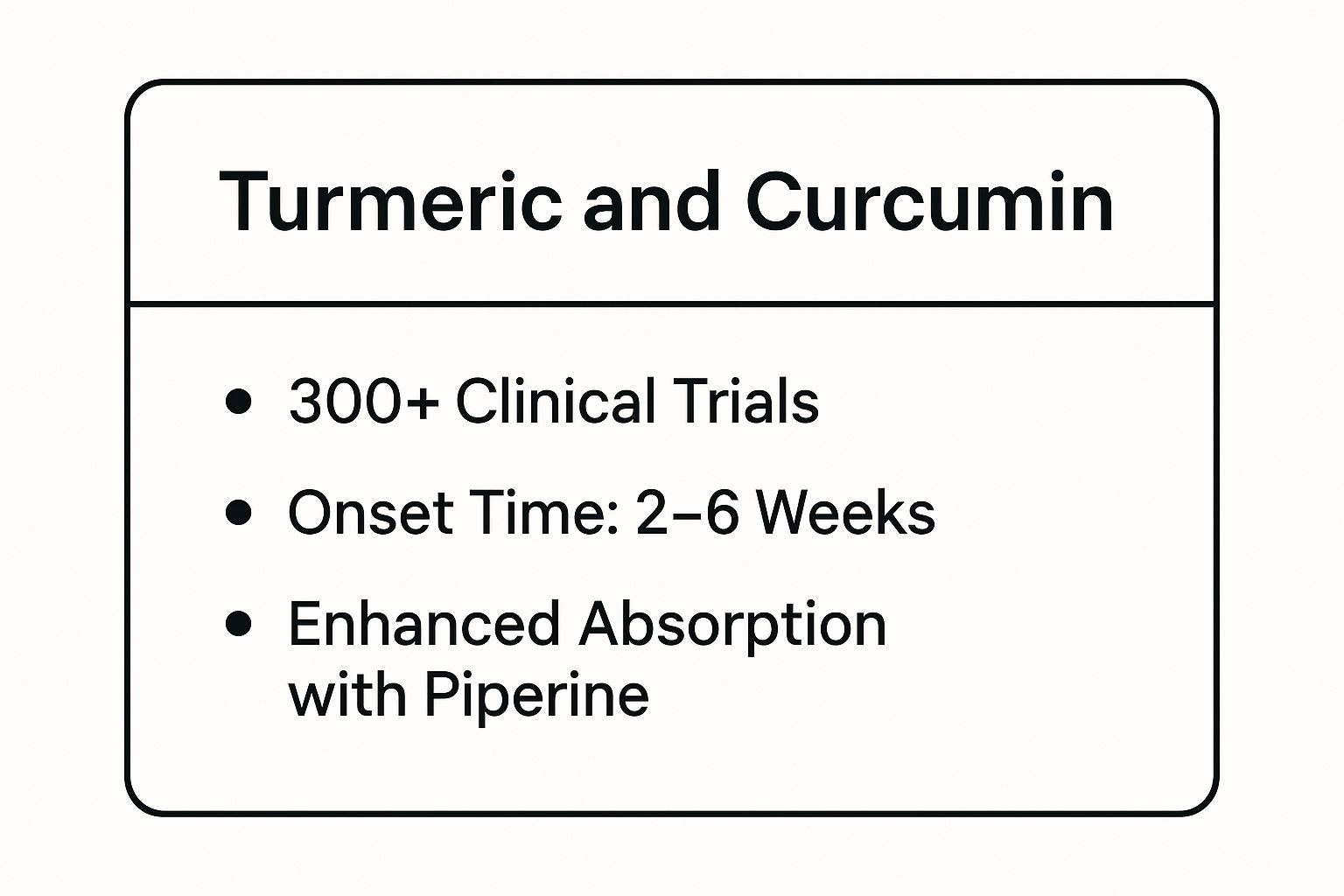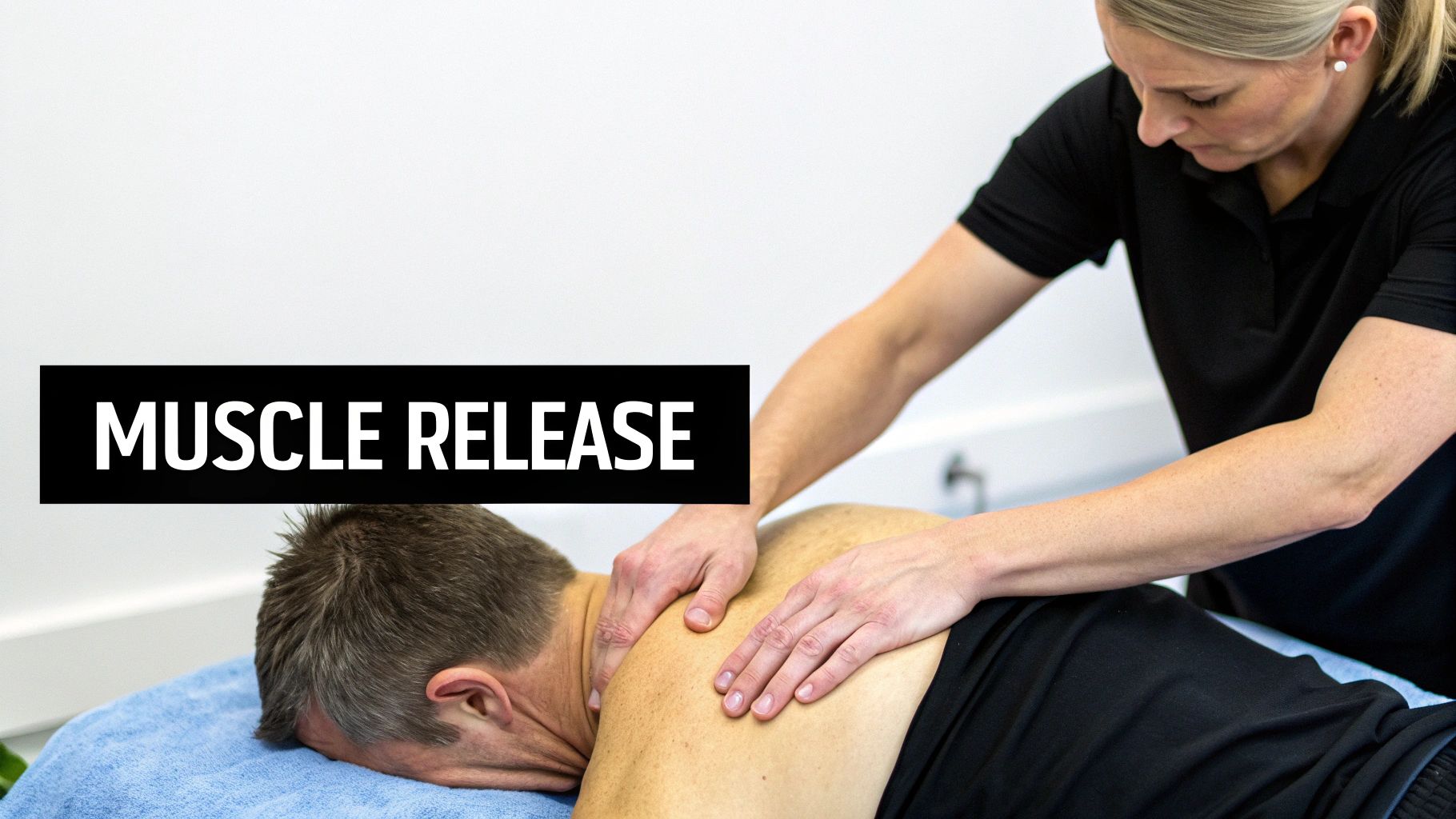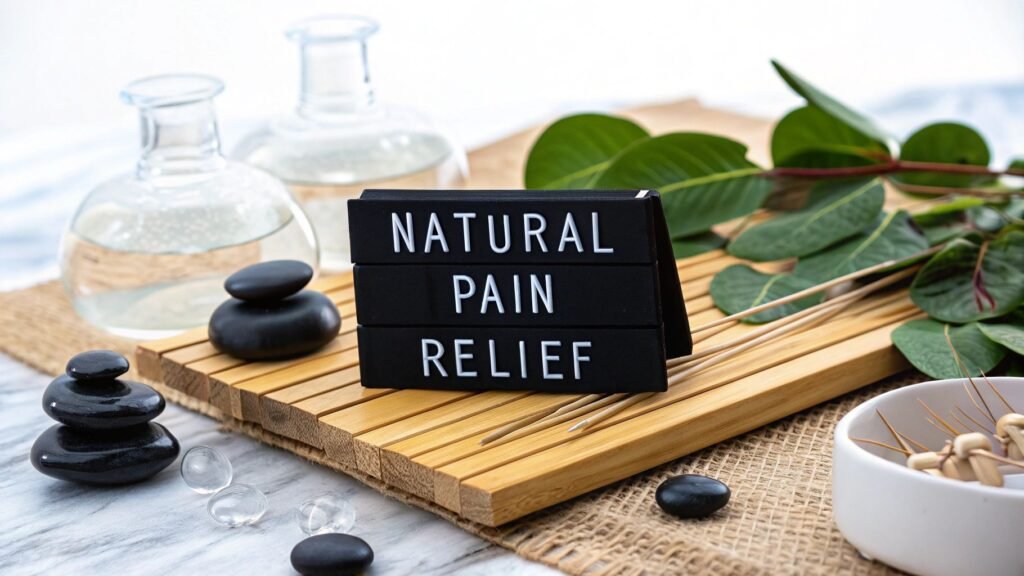Living with chronic pain can feel like a relentless cycle, where finding lasting comfort seems just out of reach. While conventional medicine offers critical support, many individuals are seeking complementary strategies that address the root causes of their discomfort, not just the symptoms. This guide is designed for those looking for a path toward sustainable, natural chronic pain relief. It moves beyond temporary fixes to explore a holistic framework for managing and reducing persistent pain.
Here, you will discover a comprehensive roundup of powerful, evidence-informed natural methods. We will delve into the specifics of ancient practices like acupuncture and herbal medicine, alongside modern nutritional science and mind-body techniques. This article provides more than just a list; it offers a detailed roadmap with actionable insights and practical implementation steps for each approach. You'll learn how to integrate these strategies into your daily life to build a personalized and effective pain management plan. The goal is to empower you with the knowledge to regain control, reduce inflammation, and enhance your overall quality of life, creating a new foundation for long-term well-being.
1. Turmeric and Curcumin Supplementation
For thousands of years, traditional Ayurvedic medicine has revered turmeric not just for its vibrant golden color but for its profound healing capabilities. The power behind this spice lies in its primary active compound, curcumin, a potent anti-inflammatory agent that offers a compelling option for natural chronic pain relief.
How It Fights Pain
Curcumin targets inflammation at the molecular level. It works by inhibiting key inflammatory enzymes, specifically COX-2 and 5-LOX, which are directly involved in the body's pain and inflammation pathways. Unlike some pharmaceuticals that only block one pathway, curcumin’s multi-pronged approach helps to quiet the entire inflammatory cascade, making it particularly effective for persistent, low-grade inflammation that drives chronic conditions.
This natural compound has shown remarkable success in managing pain from arthritis, fibromyalgia, and general inflammatory disorders. Studies have documented arthritis patients experiencing a 50-60% reduction in pain after just eight weeks of consistent curcumin use. It's a testament to its efficacy as a foundational element in an integrative pain management strategy.
For a quick reference on its clinical backing and usage, here are some key takeaways.

The data highlights that curcumin is not only well-researched but requires patience and proper formulation for optimal results.
Practical Tips for Supplementation
To effectively incorporate curcumin into your routine, consider these actionable steps:
- Boost Bioavailability: Curcumin is poorly absorbed on its own. Always choose a supplement that includes black pepper extract (piperine) or is formulated in a liposomal or phytosome form to dramatically enhance absorption.
- Start with a Therapeutic Dose: Begin with a 500mg daily dose of a standardized extract containing 95% curcuminoids. You can gradually increase to 1000-1500mg daily, preferably in divided doses.
- Take with Healthy Fats: Consume your curcumin supplement with a meal that includes healthy fats like avocado, olive oil, or nuts to further improve its absorption into your system.
2. Mindfulness Meditation and Mind-Body Techniques
While many approaches target the physical source of pain, mind-body techniques address the brain's perception and processing of it. Mindfulness meditation trains the mind to focus on present-moment awareness, which can fundamentally alter how you experience discomfort, offering a powerful avenue for natural chronic pain relief.

How It Fights Pain
Mindfulness works by activating the parasympathetic nervous system, the body's "rest and digest" mode, which counteracts the chronic stress response that often accompanies persistent pain. This practice has been shown to reduce activity in brain regions associated with pain perception while increasing activity in areas responsible for self-regulation. Instead of fighting against the pain, you learn to observe it without judgment, which can lessen its emotional and physical intensity.
The effectiveness of this approach is well-documented. Studies on Mindfulness-Based Stress Reduction (MBSR) programs, pioneered by Jon Kabat-Zinn, show chronic back pain patients reporting significant pain reduction. Similarly, individuals with fibromyalgia and cancer-related pain have used these techniques to improve pain tolerance and overall quality of life. The goal is not to eliminate pain entirely but to change your relationship with it.
Practical Tips for Implementation
To effectively integrate mindfulness into your daily life, consider these actionable steps:
- Start Small: Begin with just 5-10 minutes of guided meditation each day. Consistency is more important than duration, especially when you are starting a new habit.
- Use Guided Resources: Apps like Headspace or Calm offer structured programs specifically for pain management, making it easier to learn the foundational techniques.
- Practice the Body Scan: Lie down and bring your attention sequentially to different parts of your body. This practice helps you develop a more acute, non-reactive awareness of physical sensations, including pain.
- Join a Community: Consider enrolling in a local or online MBSR class. A structured group setting provides expert guidance and peer support, which can be invaluable for maintaining motivation.
3. Acupuncture and Traditional Chinese Medicine
A cornerstone of Traditional Chinese Medicine (TCM) for over 3,000 years, acupuncture is a sophisticated practice that involves inserting ultra-thin needles into specific points on the body. This technique is designed to rebalance the body's energy flow, or qi, providing a powerful form of natural chronic pain relief by stimulating the body’s innate healing mechanisms.

How It Fights Pain
From a modern scientific perspective, acupuncture initiates a cascade of physiological responses. The needle stimulation triggers the nervous system to release endorphins, which are the body's natural painkillers. It also activates descending pain inhibitory pathways and modulates key neurotransmitters like serotonin and norepinephrine, which play a crucial role in mood and pain perception.
This dual approach of balancing qi and influencing neurochemical pathways makes it highly effective for various chronic pain conditions. Clinical studies have demonstrated significant success, with chronic low back pain patients often reporting a 50% improvement after a course of treatment. It has also proven effective in reducing the frequency and intensity of migraines and alleviating joint pain from osteoarthritis.
Practical Tips for Treatment
To get the most out of acupuncture for chronic pain management, consider these key steps:
- Find a Qualified Practitioner: Seek a licensed acupuncturist (L.Ac.) with proper credentials and experience in treating chronic pain conditions. This ensures both safety and efficacy.
- Commit to a Treatment Plan: Chronic conditions require consistency. Expect to attend a series of 6-12 sessions, often weekly or bi-weekly, to achieve optimal and lasting results.
- Communicate Openly: Your practitioner needs to know about your pain levels, any changes you experience, and any discomfort during the session to tailor the treatment effectively.
- Consider Advanced Techniques: For more severe or stubborn pain, ask about electroacupuncture. This method involves passing a small electrical current through the needles to enhance stimulation and provide stronger pain relief.
4. Omega-3 Fatty Acids and an Anti-Inflammatory Diet
While many pain relief methods focus on suppressing symptoms, an anti-inflammatory diet built around omega-3 fatty acids targets the root cause of many chronic conditions. These essential fats, particularly EPA (eicosapentaenoic acid) and DHA (docosahexaenoic acid), provide the building blocks for the body to actively resolve inflammation, offering a foundational strategy for lasting natural chronic pain relief.
How It Fights Pain
Omega-3s are converted into powerful molecules known as specialized pro-resolving mediators (SPMs). Unlike anti-inflammatory drugs that simply block inflammatory signals, SPMs actively turn them off and initiate tissue repair and healing. This process helps shut down the chronic inflammatory cycle that perpetuates pain in conditions like rheumatoid arthritis, back pain, and fibromyalgia.
By shifting your diet to be rich in these fats and other anti-inflammatory foods like berries and leafy greens, you can reduce systemic inflammation and lower your body's overall pain sensitivity. Studies have demonstrated significant improvements, with rheumatoid arthritis patients experiencing less joint pain after supplementing with 2-3 grams of EPA/DHA daily. Adopting this dietary approach provides your body with the tools it needs to manage inflammation from the inside out.
Practical Tips for Supplementation and Diet
To effectively harness the power of an anti-inflammatory diet, consider these actionable steps:
- Aim for a Therapeutic Dose: For tangible pain relief, target 2-3 grams of combined EPA and DHA daily from a high-quality fish oil supplement. Always look for third-party tested brands to ensure purity and potency.
- Balance Your Fats: Actively reduce your intake of pro-inflammatory omega-6 fatty acids found in processed vegetable oils, fried foods, and packaged snacks. This helps create a more favorable anti-inflammatory ratio in your body.
- Eat the Rainbow: Incorporate a wide variety of colorful fruits and vegetables, such as berries, kale, and beets. These foods are packed with antioxidants and phytonutrients that combat oxidative stress and support the body’s anti-inflammatory processes.
5. Therapeutic Massage and Myofascial Release
Recognized globally for its immediate and lasting benefits, therapeutic massage offers a hands-on approach to natural chronic pain relief. It involves the systematic manipulation of the body's soft tissues to ease muscle tension, improve circulation, and trigger the body's own pain-relieving mechanisms. A specialized form, myofascial release, specifically targets the fascia, the web of connective tissue that surrounds muscles, which can become restricted and painful.

How It Fights Pain
Therapeutic massage and myofascial release work by breaking down painful adhesions, or "knots," in muscle and fascial tissue. This process increases blood flow to the affected areas, delivering oxygen and nutrients while flushing out metabolic waste. The physical manipulation also stimulates the release of endorphins, the body's natural painkillers, creating a powerful sense of well-being and pain reduction.
These techniques are highly effective for conditions rooted in musculoskeletal tension. For instance, individuals with chronic neck pain have reported a 60% improvement after a consistent massage regimen. It is also a cornerstone therapy for managing fibromyalgia symptoms, with many sufferers finding relief through weekly sessions that improve both pain levels and sleep quality.
Practical Tips for Receiving Massage
To maximize the benefits of your massage therapy sessions, follow these actionable guidelines:
- Communicate Clearly: Always inform your therapist about your pain levels, sensitive areas, and pressure preferences. Effective communication ensures the treatment is both safe and tailored to your needs.
- Hydrate After Your Session: Drink plenty of water after a massage. This helps your lymphatic system flush out the toxins and metabolic byproducts released from your muscle tissues during the session.
- Learn Self-Massage: Ask your therapist for simple self-massage techniques using tools like foam rollers or massage balls. Daily maintenance can extend the benefits of professional sessions and manage flare-ups between appointments.
- Consider Affordability: If cost is a barrier, look into local massage therapy schools. They often provide high-quality, supervised massages at a significantly reduced rate.
6. Heat and Cold Therapy (Thermotherapy)
The strategic application of temperature, known as thermotherapy, is one of the most accessible and time-tested methods for pain management. This fundamental technique offers a powerful, non-invasive approach to natural chronic pain relief by directly influencing blood flow, nerve activity, and muscle tension to soothe discomfort and support healing.
How It Fights Pain
Heat and cold therapy work through distinct physiological mechanisms. Heat therapy (thermotherapy) promotes vasodilation, increasing blood flow to the targeted area. This enhanced circulation delivers oxygen and nutrients while helping to flush out metabolic waste products, which can relax tight muscles and alleviate stiffness in joints. It is particularly effective for chronic muscle soreness, arthritis, and persistent stiffness.
Conversely, cold therapy (cryotherapy) causes vasoconstriction, which reduces blood flow. This process helps decrease inflammation, swelling, and nerve activity in the affected area, effectively numbing the pain signals sent to the brain. It is the go-to method for acute injuries, flare-ups of inflammatory conditions, and post-exertion soreness. Alternating between the two, known as contrast therapy, can create a "pumping" action that further reduces swelling and stimulates healing.
Practical Tips for Application
To harness the full benefits of thermotherapy safely and effectively, follow these specific guidelines:
- Use Heat for Stiffness: Apply heat for chronic conditions like persistent back pain or arthritic joint stiffness. Use a heating pad or warm compress for 15-20 minutes at a time.
- Use Cold for Inflammation: Use a cold pack or ice wrapped in a towel for acute injuries, swelling, or post-activity soreness. Apply for 10-15 minutes to avoid skin damage.
- Protect Your Skin: Always place a protective barrier, like a towel, between your skin and the heat or cold source to prevent burns or frostbite.
- Try Contrast Therapy: For stubborn pain and swelling, alternate 3 minutes of heat with 1 minute of cold. Repeat this cycle 3-4 times to maximize circulatory benefits.
- Listen to Your Body: Discontinue use immediately if you notice excessive redness, blistering, or numbness. Never fall asleep while using a heat or cold pack.
7. Herbal Medicine and Botanical Pain Relievers
Long before modern pharmacology, ancient cultures around the globe relied on the healing power of plants. Herbal medicine harnesses these potent botanical compounds, many of which have been used for millennia to offer effective, natural chronic pain relief by targeting the root causes of discomfort and inflammation.
How It Fights Pain
Botanical pain relievers work through diverse and sophisticated mechanisms. For example, white willow bark contains salicin, the natural precursor to aspirin, which works by inhibiting COX enzymes involved in creating inflammatory prostaglandins. Other herbs, like boswellia (frankincense), block different inflammatory pathways, such as leukotrienes, making it highly effective for joint pain and inflammatory bowel conditions.
This multi-faceted approach allows herbal medicine to address complex pain syndromes. Capsaicin, derived from chili peppers, depletes Substance P, a neurotransmitter that signals pain to the brain, providing relief for nerve pain. Similarly, devil’s claw has shown promise in reducing osteoarthritis pain and back pain. Combining these botanicals in a personalized protocol can create a synergistic effect, offering broad-spectrum relief with a lower risk of side effects compared to many synthetic drugs.
Practical Tips for Supplementation
To safely and effectively use herbal remedies for pain management, follow these practical guidelines:
- Choose Standardized Extracts: Opt for products with standardized extracts to ensure you receive a consistent and therapeutic dose of the active compounds in every batch. Look for third-party testing for purity and potency.
- Start Low and Go Slow: Begin with the lowest recommended dose to assess your body's tolerance and response. You can gradually increase the dosage under the guidance of a healthcare professional.
- Consult a Professional: Always discuss herbal supplements with your doctor or a qualified herbalist, especially if you are taking other medications, to avoid potential interactions and create a safe, personalized plan.
8. Gentle Movement and Therapeutic Exercise
When grappling with persistent pain, the instinct is often to rest and avoid activity. However, therapeutic exercise and gentle movement are fundamental pillars of natural chronic pain relief, championed by pioneers like B.K.S. Iyengar for therapeutic yoga and supported by physical therapy associations worldwide. Practices like yoga, tai chi, and targeted exercises break the debilitating cycle of pain and inactivity.
How It Fights Pain
Gentle movement works on multiple fronts to alleviate discomfort. It strengthens the muscles that support painful joints, improves flexibility to reduce stiffness, and enhances circulation to deliver oxygen and nutrients to damaged tissues. Crucially, physical activity triggers the brain to release endorphins, the body's own powerful pain-relieving chemicals.
This approach is particularly effective because it addresses both the physical and psychological components of chronic pain. By demonstrating that movement can be safe and beneficial, it helps reduce the fear and anxiety that often intensify pain perception. Success stories include individuals with chronic back pain using yoga to restore flexibility and those with arthritis practicing tai chi to regain joint mobility and balance.
Watch this guided routine for a practical example of how gentle movement can be incorporated into your day.
The key takeaway is that the right kind of movement is not a cause of pain, but a solution to it.
Practical Tips for Implementation
To safely integrate therapeutic movement into your pain management plan, follow these actionable guidelines:
- Start Slowly and Gently: Begin with short sessions, perhaps just 5-10 minutes a day. The goal is consistency, not intensity. Gradually increase the duration and difficulty as your body adapts.
- Listen to Your Body: Pay close attention to your body's signals. A mild feeling of muscle work is good, but sharp, increasing, or radiating pain is a sign to stop or modify the movement.
- Seek Qualified Guidance: Work with a physical therapist, a certified yoga instructor experienced with pain management, or a tai chi master. They can provide personalized exercises and ensure you are using proper form to prevent injury.
- Combine with Mindful Breathing: Focus on deep, steady breathing during your exercises. This enhances the relaxation response, reduces muscle tension, and deepens the mind-body connection for greater pain relief.
Natural Chronic Pain Relief Methods Comparison
| Method | Implementation Complexity 🔄 | Resource Requirements 💡 | Expected Outcomes ⭐📊 | Ideal Use Cases 💡 | Key Advantages ⭐⚡ |
|---|---|---|---|---|---|
| Turmeric and Curcumin Supplementation | Moderate – requires attention to formulation and dosage | Supplements or spice; enhanced by piperine; bioavailability issues | Moderate to high; 2-6 weeks onset; reduces inflammation and chronic pain | Arthritis, fibromyalgia, inflammatory disorders | Natural anti-inflammatory; well-researched; multiple health benefits |
| Mindfulness Meditation and Mind-Body Techniques | High – requires daily, consistent mental practice | Minimal; guided apps or classes recommended | High effectiveness reported (60-70%); gradual (8-12 weeks) pain reduction | Chronic pain with emotional components, stress-related pain | No side effects; builds coping skills; accessible anytime |
| Acupuncture and Traditional Chinese Medicine | High – needs skilled licensed practitioner | Multiple sessions; professional services needed | Immediate pain relief possible; sustained benefit after multiple sessions | Chronic pain including back pain, migraine, arthritis | Minimal side effects; recognized by WHO; may reduce medication need |
| Omega-3 Fatty Acids and Anti-Inflammatory Diet | Moderate – requires dietary changes or supplements | Food sources or supplements; quality varies | Moderate; effects appear in 2-3 months; reduces systemic inflammation | Inflammatory pain conditions; arthritis; cardiovascular benefit | Addresses root cause inflammation; brain and heart benefits |
| Therapeutic Massage and Myofascial Release | Moderate – requires trained therapist or self-techniques | Licensed therapists or self-administered tools | Immediate but often temporary relief; improves flexibility & circulation | Muscle pain, fibromyalgia, stress-related pain | Immediate relaxation; non-invasive; improves circulation |
| Heat and Cold Therapy (Thermotherapy) | Low – easy to apply but requires careful timing | Heating pads, ice packs, baths; widely available | Immediate but temporary pain relief; effective for acute and chronic pain | Acute injuries, arthritis, muscle soreness | Inexpensive; no side effects when used properly |
| Herbal Medicine and Botanical Pain Relievers | Moderate – requires product quality scrutiny and knowledge | Various forms; teas, extracts, topical | Slow onset; variable depending on herbs; natural alternatives | Mild to moderate pain; those seeking natural remedies | Fewer side effects; multiple mechanisms; affordable |
| Gentle Movement and Therapeutic Exercise | High – requires consistent practice and proper guidance | Minimal equipment; classes or videos suggested | Builds long-term strength and resilience; improves mood; slow progress | Chronic musculoskeletal pain; arthritis; fibromyalgia | Addresses physical and emotional pain; empowers patients |
Crafting Your Personalized Path to Wellness
Navigating the landscape of chronic pain can feel overwhelming, but as we've explored, a rich tapestry of natural, effective solutions is available to you. This journey has highlighted the power of an integrative approach, moving beyond a one-size-fits-all mentality to embrace a more holistic and personalized strategy for wellness. We've seen how ancient traditions and modern science converge to offer powerful tools for managing discomfort and reclaiming your quality of life.
From the cellular-level anti-inflammatory action of turmeric and omega-3s to the mind-calming power of mindfulness meditation, each method provides a unique pathway to relief. The key takeaway is not to view these strategies as isolated fixes but as interconnected components of a comprehensive self-care plan. Mastering these approaches is valuable because it empowers you to become an active participant in your own healing, transforming your relationship with your body from one of conflict to one of collaboration.
Your Next Steps Toward Natural Chronic Pain Relief
The true power of this knowledge lies in its application. The goal is to move from understanding these concepts to integrating them into your daily life. This is where the journey toward lasting natural chronic pain relief truly begins. You don't have to implement everything at once. Instead, focus on building a sustainable routine, one small, manageable step at a time.
Here are some actionable next steps to guide you:
- Start Small and Be Consistent: Choose one or two methods that resonate most with you. Perhaps it's adding a high-quality curcumin supplement to your morning routine or dedicating just ten minutes each day to a guided meditation session. Consistency is far more impactful than intensity.
- Track Your Progress: Keep a simple pain journal. Note your pain levels, energy, and mood, and track which interventions you've used. This data will reveal patterns over time, helping you identify what works best for your unique body and condition.
- Layer Your Strategies: Think of these methods as synergistic. For instance, you could combine the benefits of an anti-inflammatory diet with regular therapeutic massage. Or, you might find that gentle yoga is more effective when you've also applied heat therapy to soothe your muscles beforehand.
Embracing an Integrative and Empowered Approach
Ultimately, this exploration is about more than just pain reduction; it's about building resilience and fostering a deeper connection to your own well-being. By integrating these natural strategies, you are not just treating symptoms. You are nurturing your body's innate capacity to heal, reducing systemic inflammation, and calming your nervous system.
The path forward is one of proactive, personalized care. It requires patience, curiosity, and a commitment to listening to your body's signals. By embracing this integrative mindset, you shift from passively managing pain to actively creating a life defined by vitality, comfort, and empowerment. Your personalized wellness plan is waiting to be built, one mindful choice at a time.
If you are in the Chino, CA area and ready to explore how Traditional Chinese Medicine can be a cornerstone of your pain management plan, consider a professional consultation. The experts at Eric Tsai Acupuncture and Herbs specialize in creating personalized treatment protocols combining acupuncture, herbal medicine, and lifestyle guidance to provide effective, natural chronic pain relief. Visit Eric Tsai Acupuncture and Herbs to learn more and schedule your appointment.

